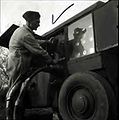Radiolocation (Radar) Unit GL III(c)
| Canadian GL III(c) | |
|---|---|
 | |
| Production history | |
| Manufacturer | Research Enterprises Limited (REL) |
| Number built | 667 |
The GL III(c)'s primary role was in locating enemy aircraft and directing Anti-Aircraft (AA) gun batteries. It was the first mobile gunlaying radar employing centimetric wavelength transmission to go into production, preceding both the British GL III (later known as AA Radar No 3 Mk 2) and the US made SCR 584 (later known as AA Radar No 3 Mk 5).[1]
The GL III(c) was comprised of two major components: the APF (accurate position finder) trailer and the ZPI (zone position indicator) trailer. The APF tracked one selected target, whereas the ZPI searched the sky for incoming targets. In addition there was a power generator, numerous heavy gauge cables, two towing vehicles (Lorry 4-ton ZPI and Lorry 4-ton APF) as well as a CMP 3-ton 4x4 winch truck for carrying supplies and equipment. All together the set of vehicles and trailers was sometimes known as the "Canadian Radar Train".[2]
The GL III(c) were used by 1 Canadian Radiolocation Unit amongst others. The majority of these photos are from a series dated 26 Jan 1943, Colchester, Hants, UK, and show an rare look at the early use of radar equipment. Other photos are from the National Research Council.










